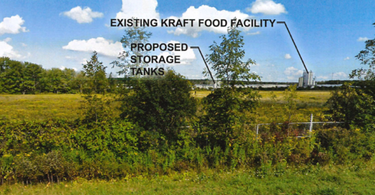ZBA approves ten 47-foot tall gas tanks for Northeastern Industrial Park
GUILDERLAND — The Guilderland Zoning Board of Appeals recently approved a special-use permit and major variance request that will allow for the construction of a liquid argon gas storage and distribution facility inside the 550-acre Northeastern Industrial Park.
The project was just one of a number of proposals, including three solar projects, reviewed by the board during a three-and-a-half hour agenda-packed Oct. 20 meeting.
Airgas USA, a major producer of gases used in manufacturing, food production, and health care, received approval to build ten 47-foot tall tanks to hold liquid argon.
The zoning board approved an area variance of 26 feet, 9 inches since the town code currently allows accessory structures in the industrial district to be 20 feet tall and the tanks will be 46 feet, 9 inches tall.
Each 13,000-gallon double-walled tank would hold argon, which is kept at a temperature of negative 300 degrees. Argon is used mainly in welding, but also in electronics manufacturing.
Argon and nitrogen, which is also proposed to be stored on-site, are inert gases, meaning they are not combustible; however, due to pressure build-up, containers holding the gases may burst in a fire.
Argon is currently trucked into the northeastern United States, where there is a shortage of the gas, the town’s planning board was told in September.
The argon would be distilled and liquified and shipped by rail to Guilderland, where the Airgas facility would be serviced by the existing rail line that runs through the industrial park. Many of the rail cars would be coming from the Gulf Coast — Louisiana, Alabama, and Mississippi — where there are large air-separation plants.
Twenty West
The zoning board also received an update on Spruce Plaza, a 1.82-acre site directly across Route 20 from Guilderland Town Hall.
First proposed in 2019, the approximately 10,000-square-foot mixed-use building would consist of professional offices, restaurants, and apartments.
There are also two proposed patios for the first floor, one for a small health-food eatery and the other for a potential restaurant or retail tenant, the board was told on Oct. 20.
Luigi Palleschi, the engineer for project developer Michael Davidson, told the board that the proposal had been updated since it was last before the board, in April. Palleschi had “fine-tuned” the building footprint and the floor plans as well as the location of doorways, he said.
There had also been a revision to the number of parking spaces, Palleschi said, and the current proposal is for 70.
Jacqueline Coons, Guilderland’s chief building and zoning inspector, said she could only apply the zoning applicable to a mixed-use building, something she said Palleschi hadn’t done, which would allow for about 35 spaces, meaning the applicant needed the variance that was advertised in the legal notice.
Coons said the on-site parking can’t be more than 125 percent of the minimum required by code; otherwise a variance is needed. With the number of peak employees estimated to be on-site on any given day at 26, Davidson said he would revise his parking estimate and come back with a request, which he estimated at about 57.
Jacob Crawford, who was running the meeting on this particular application because Chairman Thomas Remmert had not been a part of the previous meeting when the project was presented, brought the conversation back to April, when there was discussion about a 1,000-square-foot roof deck that Matt Hulihan had thought would look directly into his backyard.
Palleschi said parking spaces had been removed and additional trees had been placed on the site plan, and noted that the current zoning allows three stories while Davidson is proposing a two-story building.
Crawford said his question remained the same as in April: How will the 42-inch railing around the second-story deck be screened, with glass, some kind of see-through iron rail system, or “screenry bush-type railing.”
Davidson jumped in and said that Hulihan’s back deck is over 200 feet away from the proposed second-story deck on his building, and that he’s offered mitigation with a cedar fence, additional trees, and then even more trees placed on a bump-out in the parking lot.
Davidson also repeated an argument that he made in April: Mitigation can be undertaken on both sides of the fence, and Hulihan has some culpability in the matter. “The responsibility doesn’t fall just on me,” Davidson said. “I have rights also.” Hulihan isn’t proposing to build 10,000 square feet of retail, restaurant, and apartment space in his backyard.
After Palleschi better explained the screening additions and then suggested that Davidson add privacy screening to the 42-inch railing. Davidson said he had no problem with the screening. He then said he would make the screening solid.
Crawford said that’s the conversation he was trying to have in April. But said additional questions remained.
After more back-and-forth, Davidson agreed to the extended parking lot bump-out and to provide a rendering of the second-floor view toward Hulihan’s backyard.
Industrial Solar
It was a busy night for the Northeastern Industrial Park with the zoning board also approving a 2.375-megawatt ground-mounted solar facility on 15 acres of land in the park for Cipriani Energy.
The board approved two variances for the project, which allows the array to be 25 feet closer to the CSX tracks — the arrays are to run alongside the track — and 45 feet closer to Stone Road than code allows.
The project is being built on a capped landfill.
The Albany County Planning Board voted to disapprove the project so a supermajority of the zoning board — a majority plus one — will be needed to override the disapproval. The county planning board disapproved the project because it hadn’t received review materials that were subsequently submitted to the town.
Dunnsville Solar
A solar project along Dunnsville Road near the Helderberg escarpment that has come before the board in a number of iterations was again before the zoning board on Oct. 20.
The zoning board voted to become the lead agency for the proposed five-megawatt solar array at 6580 Dunnsville Road.
The proposed solar array initially led to an organized public outcry and inspired not one but two solar laws, but is now quietly progressing through the approval process. The Guilderland Planning Board at its April 14 meeting signed off on the facility’s site plan and sent the application back to the zoning board.
Helios Energy in 2019 had proposed to install the solar array on a sloping 61-acre field at 6604 Dunnsville Road, owned by Joseph Muia, overlooking Orchard Creek, the golf course owned by the Abbruzzese family.
The organized objection to the proposal led the town to make additions to its original solar law, and eventually the two sides came to an agreement on the project. The array is now proposed for 6580 Dunnsville Road, a nearly 57-acre Abbruzzese-owned property adjacent to Muia’s, property which Muia is slated to take ownership of.
The proposal also inspired a law, adopted by the county legislature in February, that says the Albany County Planning Board must now consider the Helderberg escarpment viewshed when making project recommendations to local planning and zoning boards. A negative recommendation from the county planning board would force a local board to approve a proposal by a supermajority vote.
Oct. 20 also acted as a public hearing for the project; the hearing was kept open.
Krumkill Solar
The zoning board closed the public hearing on what could become the largest solar project in town, but did not take any action on the project.
Borrego Solar Systems is seeking to install an 8.84-megawatt large-scale, ground-mounted, solar array on about 87 acres of land owned by JL Development that straddles Guilderland and New Scotland.
The project recently received close scrutiny from the New Scotland Planning Board, which was ultimately OK with the proposal but asked for conditions to be attached to its approval.
Borrego is seeking variances to be able to clear-cut more trees than code allows and to have its solar panels located closer to all the neighbors’ property lines than what is currently allowed by law, which was one of the reforms included in the April 2020 amendments package to the town’s solar law.
Borrego is requesting a variance from the town’s clear-cutting code requirements: Guilderland allows only 20,000 square feet, about half of an acre (43,560 square feet in one acre), and the applicant wants to remove 2.4 acres of trees.
In addition, the company is requesting a reduction in the front, side, and rear property-line setbacks: Borrego wants a 50-foot setback from the neighboring property lines wile a 150-foot setback is required for the front and side, and 200 feet is required for a rear setback.
Remmert acknowledged criticisms levied against the project: that the town’s solar law had recently been amended when the project was first proposed, and the first application that comes before the board is looking for a variance from that law.
“I understand that,” Remmert said, but the people who offered that criticism do not live in that part of town, while the adjacent property owner was OK with the proposal. “While I do value all the public comment, I do place more value on the immediate neighbors’ [opinion],” he said.
The board said it needed just a few more documents from Borrego before it could render its decision, electing to put off the proposal until its next meeting, currently set for Nov. 3.
Extended deadline
Finally, the zoning board approved a special-use permit extension request from a building owner looking to convert his existing office building to a mixed-use.
Last December, the board approved the permit and a three-and-a-half-foot variance for 2390 Western Ave. since town code doesn’t allow for buildings taller than 35 feet.
Troy Miller was approved to add two stories to the building, with each floor slated to contain four three-bedroom apartments, and an additional apartment on the first floor.
The approval of the variance drew criticism from several residents at the time.



